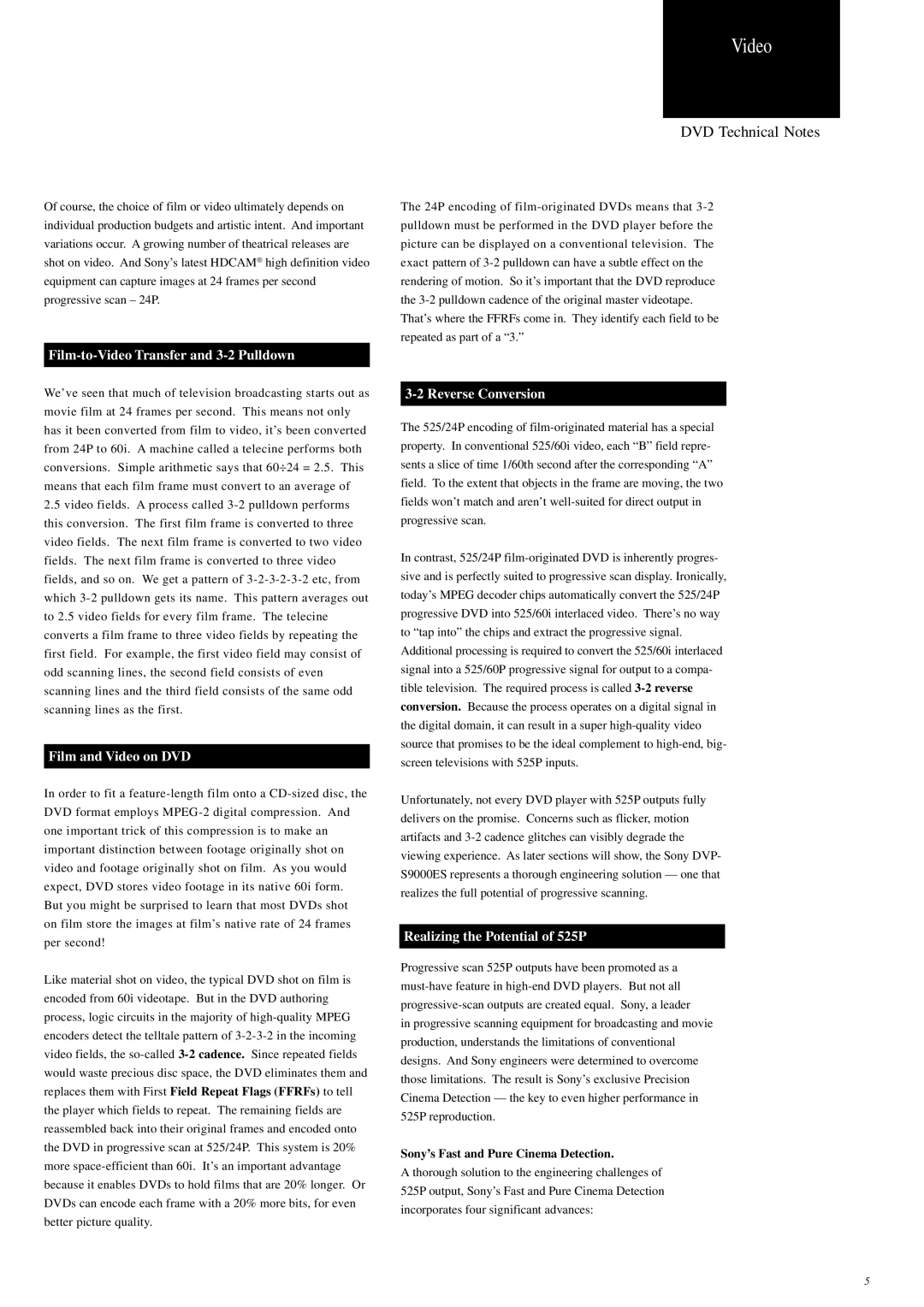Of course, the choice of film or video ultimately depends on individual production budgets and artistic intent. And important variations occur. A growing number of theatrical releases are shot on video. And Sony’s latest HDCAM ® high definition video equipment can capture images at 24 frames per second progressive scan – 24P.
Film-to-Video Transfer and 3-2 Pulldown
We’ve seen that much of television broadcasting starts out as movie film at 24 frames per second. This means not only has it been converted from film to video, it’s been converted from 24P to 60i. A machine called a telecine performs both conversions. Simple arithmetic says that 60÷24 = 2.5. This means that each film frame must convert to an average of
2.5video fields. A process called 3-2 pulldown performs this conversion. The first film frame is converted to three video fields. The next film frame is converted to two video fields. The next film frame is converted to three video fields, and so on. We get a pattern of 3-2-3-2-3-2 etc, from which 3-2 pulldown gets its name. This pattern averages out to 2.5 video fields for every film frame. The telecine converts a film frame to three video fields by repeating the first field. For example, the first video field may consist of odd scanning lines, the second field consists of even scanning lines and the third field consists of the same odd scanning lines as the first.
Film and Video on DVD
In order to fit a feature-length film onto a CD-sized disc, the DVD format employs MPEG-2 digital compression. And one important trick of this compression is to make an important distinction between footage originally shot on video and footage originally shot on film. As you would expect, DVD stores video footage in its native 60i form.
But you might be surprised to learn that most DVDs shot on film store the images at film’s native rate of 24 frames per second!
Like material shot on video, the typical DVD shot on film is encoded from 60i videotape. But in the DVD authoring process, logic circuits in the majority of high-quality MPEG encoders detect the telltale pattern of 3-2-3-2 in the incoming video fields, the so-called 3-2 cadence. Since repeated fields would waste precious disc space, the DVD eliminates them and replaces them with First Field Repeat Flags (FFRFs) to tell the player which fields to repeat. The remaining fields are reassembled back into their original frames and encoded onto the DVD in progressive scan at 525/24P. This system is 20% more space-efficient than 60i. It’s an important advantage because it enables DVDs to hold films that are 20% longer. Or DVDs can encode each frame with a 20% more bits, for even better picture quality.
The 24P encoding of film-originated DVDs means that 3-2 pulldown must be performed in the DVD player before the picture can be displayed on a conventional television. The exact pattern of 3-2 pulldown can have a subtle effect on the rendering of motion. So it’s important that the DVD reproduce the 3-2 pulldown cadence of the original master videotape. That’s where the FFRFs come in. They identify each field to be repeated as part of a “3.”
3-2 Reverse Conversion
The 525/24P encoding of film-originated material has a special property. In conventional 525/60i video, each “B” field repre- sents a slice of time 1/60th second after the corresponding “A” field. To the extent that objects in the frame are moving, the two fields won’t match and aren’t well-suited for direct output in progressive scan.
In contrast, 525/24P film-originated DVD is inherently progres- sive and is perfectly suited to progressive scan display. Ironically, today’s MPEG decoder chips automatically convert the 525/24P progressive DVD into 525/60i interlaced video. There’s no way to “tap into” the chips and extract the progressive signal. Additional processing is required to convert the 525/60i interlaced signal into a 525/60P progressive signal for output to a compa- tible television. The required process is called 3-2 reverse conversion. Because the process operates on a digital signal in the digital domain, it can result in a super high-quality video source that promises to be the ideal complement to high-end, big- screen televisions with 525P inputs.
Unfortunately, not every DVD player with 525P outputs fully delivers on the promise. Concerns such as flicker, motion artifacts and 3-2 cadence glitches can visibly degrade the viewing experience. As later sections will show, the Sony DVP- S9000ES represents a thorough engineering solution — one that realizes the full potential of progressive scanning.
Realizing the Potential of 525P
Progressive scan 525P outputs have been promoted as a must-have feature in high-end DVD players. But not all progressive-scan outputs are created equal. Sony, a leader
in progressive scanning equipment for broadcasting and movie production, understands the limitations of conventional designs. And Sony engineers were determined to overcome those limitations. The result is Sony’s exclusive Precision Cinema Detection — the key to even higher performance in 525P reproduction.
Sony’s Fast and Pure Cinema Detection.
A thorough solution to the engineering challenges of 525P output, Sony’s Fast and Pure Cinema Detection incorporates four significant advances:

